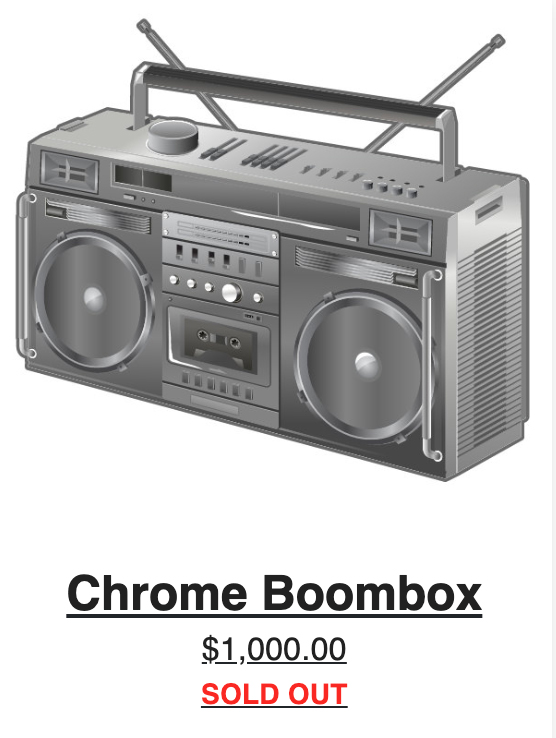萊爾·奧威爾科是一位著名攝影師,知名作品包括一張標(biāo)志性的“9·11”照片和一個名為“立體聲錄放機(jī)項(xiàng)目”(Boombox Project)的系列,該系列的主顧包括麥當(dāng)娜、Jay-Z等。3月中旬的一天,全美大部分地區(qū)都因?yàn)樾鹿诓《咎幱诜怄i狀態(tài),奧威爾科的一個新展覽開幕了,不過是在網(wǎng)上。
這次展覽是立體聲錄放機(jī)項(xiàng)目的延伸,展出了幾十種不同顏色獨(dú)一無二的數(shù)碼圖片,單價在20美元到2500美元之間。讓奧威爾科驚喜的是,大部分展品都賣光了,包括下面這張:

這次展覽在Nifty Gateway上舉行,越來越多像Nifty Gateway一樣的網(wǎng)站使用區(qū)塊鏈技術(shù)為收藏者提供獨(dú)一無二的藝術(shù)藏品。區(qū)塊鏈的使用保證了交易記錄無法被篡改破壞,也就是說,一幅數(shù)字圖像可以被認(rèn)定為獨(dú)一無二的正版藏品——哪怕屏幕截圖很容易就能進(jìn)行復(fù)制,就像上圖一樣。
“確保數(shù)字藝術(shù)品的稀缺性在以前是不可能實(shí)現(xiàn)的。數(shù)字藝術(shù)運(yùn)動已經(jīng)開始了幾十年,但直到最近,才能把數(shù)字藝術(shù)品包起來當(dāng)成資產(chǎn)。”泰勒·文克萊沃斯說,他和他的孿生兄弟卡梅倫是Nifty Gateway的共同所有者,這家公司成立于2018年。
文克萊沃斯兄弟是比特幣億萬富翁,因?yàn)楹婉R克·扎克伯格就Facebook的創(chuàng)立打官司而聲名鵲起。對他們來說,區(qū)塊鏈技術(shù)有望打造一個全新的大型藝術(shù)品和收藏品市場。他們希望收藏者能夠看到,數(shù)字藝術(shù)品可以像原版印刷品或畫像一樣獨(dú)一無二——即使被大量復(fù)制放在禮品店里售賣,也還是能賣出大價錢。
Nifty Gateway由另一對雙胞胎鄧肯和格里芬·考克·福斯特經(jīng)營,該公司表示,截至目前已經(jīng)賣出了數(shù)千件數(shù)字收藏品,不過沒有透露具體數(shù)量,也沒有透露網(wǎng)站的總營收。
對于立體聲錄放機(jī)系列的作者奧威爾科來說,區(qū)塊鏈還有助于打擊明目張膽的偽造和非法復(fù)制,長期以來,這些行為讓互聯(lián)網(wǎng)時代的藝術(shù)家們倍感沮喪。他將區(qū)塊鏈的追蹤系統(tǒng)比作車輛識別碼(VIN),提供了一種登記和識別購入和售出的每一輛汽車的方法。
根據(jù)文克萊沃斯兄弟的說法,當(dāng)藝術(shù)家的作品被轉(zhuǎn)售時,像Nifty Gateway這樣的數(shù)字藝術(shù)門戶為藝術(shù)家提供了一種收取版稅的新方式,一種和實(shí)體藝術(shù)品行業(yè)不同的方式。他們還聲稱,在原始銷售中他們收取的傭金比例遠(yuǎn)低于實(shí)體畫廊通常收取的50%。
該公司拒絕透露從銷售中收取的具體傭金,也不愿透露藝術(shù)家轉(zhuǎn)售作品時能得到的版稅。
數(shù)字藝術(shù)品通常包括網(wǎng)上出售的照片和插圖,盡管它們在新冠肺炎大流行期間可能得到了新的關(guān)注,但相較于更廣泛的藝術(shù)市場而言,仍然只占很小的一部分,而且對于許多藝術(shù)愛好者來說并不熟悉。
傳統(tǒng)畫廊行業(yè)在疫情期間遭受重創(chuàng)。《洛杉磯時報》(Los Angeles Times)的一項(xiàng)調(diào)查顯示,當(dāng)?shù)氐囊慌嬂然驅(qū)㈥P(guān)閉,幾十家畫廊已經(jīng)申請了薪酬保障計(jì)劃(Paycheck Protection Program)。一些店主還在思考今后的展覽如何開展,因?yàn)橹荒茉试S少數(shù)人進(jìn)入以維持社交距離,還有一些店主則提供了“在線參觀室”(也就是網(wǎng)站),讓藝術(shù)愛好者可以在線觀賞以及購買作品。不過,在《洛杉磯時報》這篇詳盡的調(diào)查報告中,并沒有提及純數(shù)字藝術(shù)的銷售。
澳大利亞插畫家凱蒂·阿靈頓對這個市場的增長仍然持樂觀態(tài)度。她一直在另一家區(qū)塊鏈藝術(shù)品門戶網(wǎng)站MakersPlace上展示她獨(dú)特的數(shù)字作品,該網(wǎng)站由在線圖釘板網(wǎng)站Pinterest的前雇員創(chuàng)建。
“它把我和一個真正熱愛數(shù)字藝術(shù)的社區(qū)聯(lián)系了起來,特別棒。”阿靈頓說,她補(bǔ)充道,使用區(qū)塊鏈軟件來展示她的插圖一開始很難,但后來就更簡便了。
Nifty Gateway選擇完全隱藏區(qū)塊鏈軟件,這意味著希望購買數(shù)字藝術(shù)品的客戶什么都不用干,只需要輸入信用卡卡號。(想要在后臺查看區(qū)塊鏈注冊表的買家也可以查看。)
然而,盡管區(qū)塊鏈技術(shù)可能有利于數(shù)字藝術(shù)開辟新市場,但這類藝術(shù)能否跳出小眾群體吸引更多收藏者,仍然是個問題。畢竟,對許多人來說,擁有藝術(shù)品的吸引力在于展示藝術(shù)品所帶來的愉悅和地位——如果藝術(shù)品被鎖在屏幕里,如何展示是個難題。
但奧威爾科樂觀地認(rèn)為,會有越來越多的人接受數(shù)字藝術(shù),部分原因是新的顯示器和數(shù)字紙將有助于更好地展示數(shù)字藝術(shù)品。
奧威爾科說:“過去三十年,我們已經(jīng)經(jīng)歷了這么多富有創(chuàng)造性的環(huán)境,這將是下一次演化。”(財富中文網(wǎng))
譯者:Agatha
萊爾·奧威爾科是一位著名攝影師,知名作品包括一張標(biāo)志性的“9·11”照片和一個名為“立體聲錄放機(jī)項(xiàng)目”(Boombox Project)的系列,該系列的主顧包括麥當(dāng)娜、Jay-Z等。3月中旬的一天,全美大部分地區(qū)都因?yàn)樾鹿诓《咎幱诜怄i狀態(tài),奧威爾科的一個新展覽開幕了,不過是在網(wǎng)上。
這次展覽是立體聲錄放機(jī)項(xiàng)目的延伸,展出了幾十種不同顏色獨(dú)一無二的數(shù)碼圖片,單價在20美元到2500美元之間。讓奧威爾科驚喜的是,大部分展品都賣光了,包括下面這張:
這次展覽在Nifty Gateway上舉行,越來越多像Nifty Gateway一樣的網(wǎng)站使用區(qū)塊鏈技術(shù)為收藏者提供獨(dú)一無二的藝術(shù)藏品。區(qū)塊鏈的使用保證了交易記錄無法被篡改破壞,也就是說,一幅數(shù)字圖像可以被認(rèn)定為獨(dú)一無二的正版藏品——哪怕屏幕截圖很容易就能進(jìn)行復(fù)制,就像上圖一樣。
“確保數(shù)字藝術(shù)品的稀缺性在以前是不可能實(shí)現(xiàn)的。數(shù)字藝術(shù)運(yùn)動已經(jīng)開始了幾十年,但直到最近,才能把數(shù)字藝術(shù)品包起來當(dāng)成資產(chǎn)。”泰勒·文克萊沃斯說,他和他的孿生兄弟卡梅倫是Nifty Gateway的共同所有者,這家公司成立于2018年。
文克萊沃斯兄弟是比特幣億萬富翁,因?yàn)楹婉R克·扎克伯格就Facebook的創(chuàng)立打官司而聲名鵲起。對他們來說,區(qū)塊鏈技術(shù)有望打造一個全新的大型藝術(shù)品和收藏品市場。他們希望收藏者能夠看到,數(shù)字藝術(shù)品可以像原版印刷品或畫像一樣獨(dú)一無二——即使被大量復(fù)制放在禮品店里售賣,也還是能賣出大價錢。
Nifty Gateway由另一對雙胞胎鄧肯和格里芬·考克·福斯特經(jīng)營,該公司表示,截至目前已經(jīng)賣出了數(shù)千件數(shù)字收藏品,不過沒有透露具體數(shù)量,也沒有透露網(wǎng)站的總營收。
對于立體聲錄放機(jī)系列的作者奧威爾科來說,區(qū)塊鏈還有助于打擊明目張膽的偽造和非法復(fù)制,長期以來,這些行為讓互聯(lián)網(wǎng)時代的藝術(shù)家們倍感沮喪。他將區(qū)塊鏈的追蹤系統(tǒng)比作車輛識別碼(VIN),提供了一種登記和識別購入和售出的每一輛汽車的方法。
根據(jù)文克萊沃斯兄弟的說法,當(dāng)藝術(shù)家的作品被轉(zhuǎn)售時,像Nifty Gateway這樣的數(shù)字藝術(shù)門戶為藝術(shù)家提供了一種收取版稅的新方式,一種和實(shí)體藝術(shù)品行業(yè)不同的方式。他們還聲稱,在原始銷售中他們收取的傭金比例遠(yuǎn)低于實(shí)體畫廊通常收取的50%。
該公司拒絕透露從銷售中收取的具體傭金,也不愿透露藝術(shù)家轉(zhuǎn)售作品時能得到的版稅。
數(shù)字藝術(shù)品通常包括網(wǎng)上出售的照片和插圖,盡管它們在新冠肺炎大流行期間可能得到了新的關(guān)注,但相較于更廣泛的藝術(shù)市場而言,仍然只占很小的一部分,而且對于許多藝術(shù)愛好者來說并不熟悉。
傳統(tǒng)畫廊行業(yè)在疫情期間遭受重創(chuàng)。《洛杉磯時報》(Los Angeles Times)的一項(xiàng)調(diào)查顯示,當(dāng)?shù)氐囊慌嬂然驅(qū)㈥P(guān)閉,幾十家畫廊已經(jīng)申請了薪酬保障計(jì)劃(Paycheck Protection Program)。一些店主還在思考今后的展覽如何開展,因?yàn)橹荒茉试S少數(shù)人進(jìn)入以維持社交距離,還有一些店主則提供了“在線參觀室”(也就是網(wǎng)站),讓藝術(shù)愛好者可以在線觀賞以及購買作品。不過,在《洛杉磯時報》這篇詳盡的調(diào)查報告中,并沒有提及純數(shù)字藝術(shù)的銷售。
澳大利亞插畫家凱蒂·阿靈頓對這個市場的增長仍然持樂觀態(tài)度。她一直在另一家區(qū)塊鏈藝術(shù)品門戶網(wǎng)站MakersPlace上展示她獨(dú)特的數(shù)字作品,該網(wǎng)站由在線圖釘板網(wǎng)站Pinterest的前雇員創(chuàng)建。
“它把我和一個真正熱愛數(shù)字藝術(shù)的社區(qū)聯(lián)系了起來,特別棒。”阿靈頓說,她補(bǔ)充道,使用區(qū)塊鏈軟件來展示她的插圖一開始很難,但后來就更簡便了。
Nifty Gateway選擇完全隱藏區(qū)塊鏈軟件,這意味著希望購買數(shù)字藝術(shù)品的客戶什么都不用干,只需要輸入信用卡卡號。(想要在后臺查看區(qū)塊鏈注冊表的買家也可以查看。)
然而,盡管區(qū)塊鏈技術(shù)可能有利于數(shù)字藝術(shù)開辟新市場,但這類藝術(shù)能否跳出小眾群體吸引更多收藏者,仍然是個問題。畢竟,對許多人來說,擁有藝術(shù)品的吸引力在于展示藝術(shù)品所帶來的愉悅和地位——如果藝術(shù)品被鎖在屏幕里,如何展示是個難題。
但奧威爾科樂觀地認(rèn)為,會有越來越多的人接受數(shù)字藝術(shù),部分原因是新的顯示器和數(shù)字紙將有助于更好地展示數(shù)字藝術(shù)品。
奧威爾科說:“過去三十年,我們已經(jīng)經(jīng)歷了這么多富有創(chuàng)造性的環(huán)境,這將是下一次演化。”(財富中文網(wǎng))
譯者:Agatha
Lyle Owerko is a celebrated photographer known for an iconic 9/11 photo, and for an art series called the Boombox Project, whose patrons include Madonna and Jay-Z. In mid-March, on a day much of the country went into lockdown because of the coronavirus, Owerko opened a new exhibition—online.
The exhibition was an extension of the Boombox Project, featuring several dozen unique digital prints in a variety of colors, costing $20 to $2,500. To Owerko's pleasant surprise, most of them sold out, including the one pictured below:
The exhibition took place on Nifty Gateway, one of a growing number of websites that use blockchain technology to offer collectors a unique work of art. The use of blockchain, which creates a tamperproof and indestructible transaction record, means that a given digital image can be designated as distinct and authentic—even if a version of it can be easily reproduced in screenshots like the one above.
"Enforcing scarcity in digital art couldn’t happen before. The digital art movement has existed for decades, but until recently you couldn’t box it up and create an asset out of it," says Tyler Winklevoss, who, along with his twin brother, Cameron, owns Nifty Gateway, which was founded in 2018.
For the Winklevoss twins, Bitcoin billionaires who gained fame for their legal battle with Mark Zuckerberg over Facebook's founding, blockchain technology promises to create a major new art and collectibles market. They hope that collectors will come to see that digital art can be unique in the same way as original prints or portraits—which can fetch enormous sums even if they are widely reproduced as gift shop collectibles.
Nifty Gateway, which is operated by a second pair of twins, Duncan and Griffin Cock Foster, says it has so far sold thousands of digital collectibles, though it has not disclosed a specific number nor the site's overall revenue.
For Owerko, the Boombox artist, blockchain also promises a way to combat the blatant counterfeiting and illicit reproduction that has long frustrated artists in the Internet age. He likens blockchain's tracing system to a vehicle identification number (VIN), which provides a way to register and identify every car bought and sold.
And according to the Winklevoss twins, digital art portals like Nifty Gateway provide a way for artists—unlike in the world of physical art—to collect royalties when one of their works is resold. They also claim that in the case of original sales, the percentage they take as a commission is much lower than the 50% physical galleries typically collect.
The company declined to disclose the specific commission it collects on sales or the royalties that artists can earn for those resales.
But while digital art, which typically consists of photos and illustrations sold on websites, may be receiving new attention during the pandemic, it's still a tiny fraction of the broader art market, and one that's unfamiliar to many art lovers.
The traditional gallery world has taken a battering during the pandemic. A survey by the Los Angeles Times suggested that a number of galleries in that city expect to close, and that dozens had applied for the Paycheck Protection Program. Some owners are also mulling future exhibits that admit only a handful of people to respect social distancing, while others are offering "online viewing rooms" (a.k.a. websites) where art fans can view and purchase works. The idea of selling purely digital art did not come up, however, in the Times' detailed overview.
Katy Arrington, an Australia-based illustrator, is nonetheless optimistic the market will grow. She has been exhibiting unique digital works on MakersPlace, another blockchain art portal, created by former employees of online pin board Pinterest.
"It connected me to a community that really valued digital art; it was pretty awesome," says Arrington, who added that using the blockchain software required to exhibit her illustrations proved difficult at first, but has since become more intuitive.
In the case of Nifty Gateway, the company opted to conceal the blockchain software altogether, meaning customers wishing to buy digital art don't have to do anything more than enter a credit card number. (Buyers who want to look under the hood at the blockchain registry are still able to do so.)
But while the technology may have arrived to facilitate a new market in digital art, it's an open question whether such art will appeal to more than a small niche of collectors. After all, the appeal of owning art for many people is the pleasure and status that can come with displaying it—a difficult proposition if the art is locked in a screen.
Owerko, however, is optimistic that a growing number of people will embrace digital art, in part because of new monitors and digital paper that will enhance the ability to display it.
Says Owerko, "We’ve moved through so many creative environments in the last three decades, that this is the next evolutionary step."






